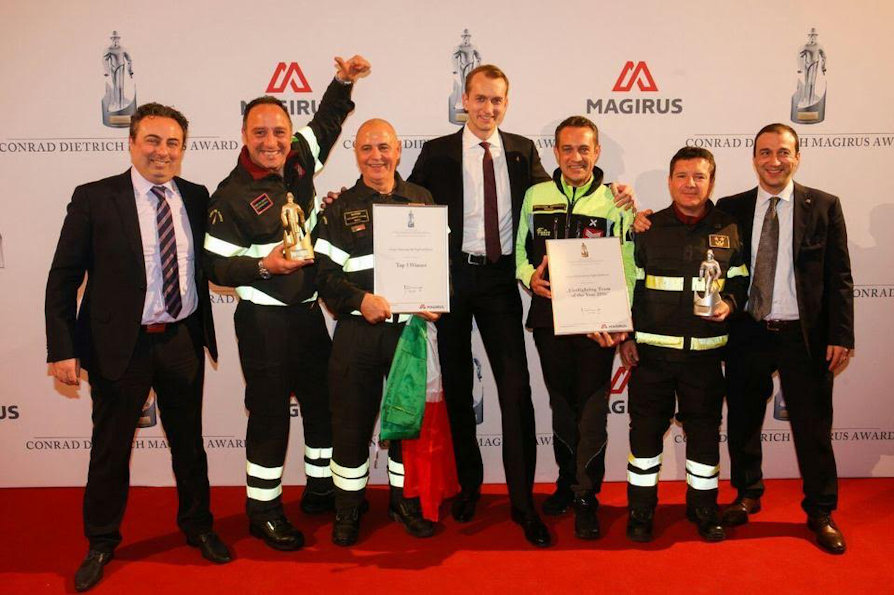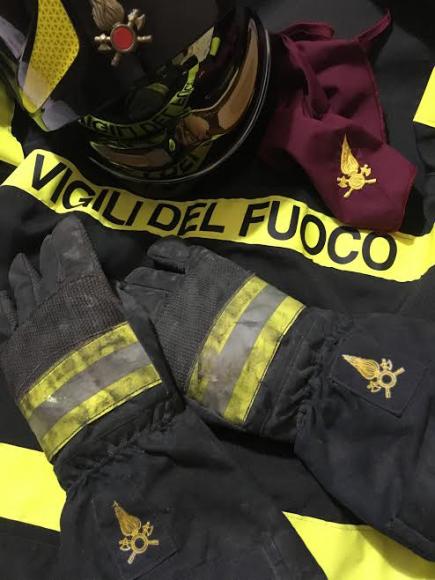"...Proud as both a citizen and a Minister of the Interior of a body that is the backbone of the National Civil Protection System, a point of excellence in our country and in the world ". Last December, during the ceremony for the celebrations of Santa Barbara, patron saint of the fire brigade, Minister Angelino Alfano gave voice to the feeling of trust that all Italians from North to South, daily express to the men and women of the National Fire Brigade Corps.
During the emergency and rescue activities, often carried out in critical conditions, the Fire Brigade testifies to their concrete wealth of skills: specialized professionals supported by suitable instrumental resources. Immediacy is a necessary requirement in all types of intervention. With dedication and responsibility I am at the service of our country. The sense of duty and the spirit of sacrifice distinguish the firefighters who work "with the heart", always alongside those who need help, give hope and work to ensure a return to normalcy, especially in extreme conditions. In the fireman's hourglass, every minute can mean the difference between life and death during an intervention.
Il National Body of Fire it is a concrete and irreplaceable reference point in the security system of our country and for all citizens. From the 2012, it is part of the National Civil Protection Service. Hierarchically it depends on the Department of Fire Brigade, Public Rescue and Civil Defense of the Ministry of the Interior. It is a civil law body with police functions, both administrative and judicial. The competences, functions and tasks of the Corps are established by the Legislative Decree 8 March 2006 n.139.
Public aid and civil defense provide for the protection of people, animals, property and urgent technical assistance. It guarantees the security of the State in case of emergency (landslides, floods, seismic events, etc.) and from external aggressions. The activity of contrast and fire prevention is carried out in relation to the type of activity, to the buildings, to the plants and the civil and industrial equipment. Fundamental is the activity of the Investigative Anti-Fire Unit to identify the causes and determine if they are malicious events.
In the last centuries Cesare Ottaviano Augusto with two reforms, one of 26 and the other of 6 BC, organized a body of defense against fire, the Militia Vigilum Regime. A special body of night guards under the command of a Prefectus Vigilum.
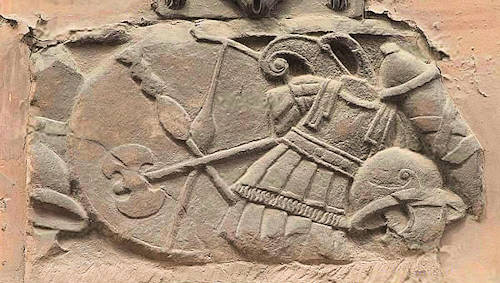 In Rome fires and collapses were frequent, most of the houses in the city, were built of wood. The streets were lit by torches: the simultaneous presence of fire and fuel caused fires almost every day. A simple distraction was enough to provoke a tragedy and to extinguish them could become a desperate undertaking. The need to create a "fire-fighting body" for investigative activity was also necessary in that historical context. The main task at the behest of Augustus was to investigate the cause of the fires and to identify and stop the authors. There Militia Vigilum it was also intended to prevent, repress fires and report to the Prefectus Vigilum to "punish" anyone for negligence or negligence making possible fires. To deal with this task i vigilum they were suitably equipped and organized logistically. The Corps consisted of 7000 men divided into 7 short and 49 centurie. Each court guaranteed service in the territory of two regions: the Statio (Barracks) was located in a region and theexcubitorium (detachment) in the other region, distributed mainly near the city wall of the Urbe.
In Rome fires and collapses were frequent, most of the houses in the city, were built of wood. The streets were lit by torches: the simultaneous presence of fire and fuel caused fires almost every day. A simple distraction was enough to provoke a tragedy and to extinguish them could become a desperate undertaking. The need to create a "fire-fighting body" for investigative activity was also necessary in that historical context. The main task at the behest of Augustus was to investigate the cause of the fires and to identify and stop the authors. There Militia Vigilum it was also intended to prevent, repress fires and report to the Prefectus Vigilum to "punish" anyone for negligence or negligence making possible fires. To deal with this task i vigilum they were suitably equipped and organized logistically. The Corps consisted of 7000 men divided into 7 short and 49 centurie. Each court guaranteed service in the territory of two regions: the Statio (Barracks) was located in a region and theexcubitorium (detachment) in the other region, distributed mainly near the city wall of the Urbe.
With the decline of the empire, the Militia Vigilum dissolved. Over the centuries, the population of the Peninsula, aggregated into Lordships, Republics, Principalities and Kingdoms, was struck by natural disasters and fires that were increasingly frequent and ruinous.
In the 1699 the French industrialist Dumourrier-Duperrier set up a fire service by using his workers. In the 1811 was born the Body of the Sapeurs-Pompiers to which all the civilized countries, including Italy, were inspired by the birth of the various Fire Protection Corps. In each capital of the various States, army units were assigned to perform the Fire Service. Many municipalities endowed themselves with Civic bodies: the Fire Brigade of Turin, Rome and Naples achieved a high degree of efficiency and professionalism.
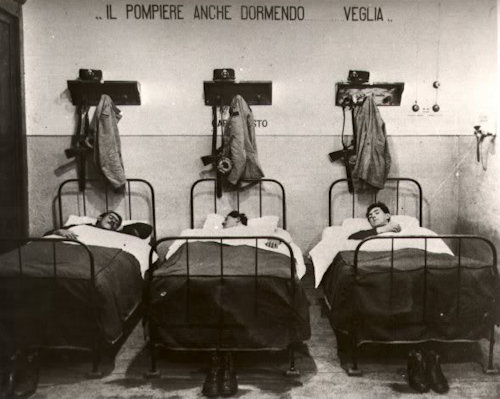 In the 1928 a law was promulgated that obliged all the municipalities with more than 40.000 thousand inhabitants to provide a Firefighter's body. These bodies proved their "limits" when called to operate for serious calamities outside their jurisdiction, the non-uniformity of the connections of the pipes of the hydrangea citizens, made the fire-fighting pumps useless. With the Royal Decree of 1935 was established under the strict dependencies of the Ministry of the Interior the National Firefighters Body. This organization provided for the formation of Provincial Bodies with offices in the provincial capitals and dependent on the Province of the Province from which they were administered.
In the 1928 a law was promulgated that obliged all the municipalities with more than 40.000 thousand inhabitants to provide a Firefighter's body. These bodies proved their "limits" when called to operate for serious calamities outside their jurisdiction, the non-uniformity of the connections of the pipes of the hydrangea citizens, made the fire-fighting pumps useless. With the Royal Decree of 1935 was established under the strict dependencies of the Ministry of the Interior the National Firefighters Body. This organization provided for the formation of Provincial Bodies with offices in the provincial capitals and dependent on the Province of the Province from which they were administered.
During the twenty years of fascism called by the Ministry of the Interior, the Prefect Alberto Giombini, was the architect of the unification of the various provincial bodies. Assisted by the commanders of the various bodies and fervent engineers, he created and organized the National Fire Brigade Corps. With a decree law of 1938 replaced the term "firefighter" of French origin with "Fireman", a term used mainly in the city of Rome (clear reference to the Vigiles of the period of Augustus). The provincial organizations were abolished by a decree of the 1939.
With the entry into the war of Italy in the 1940, the National Corps of Firefighters was immediately put to the test. Also during the Second World War, following the bombings, the fire brigades actively participated in the defense of the territory and to the rescue of people, paying a very high tribute in terms of human lives.
The process of unification of the provincial bodies that operated autonomously, ended in 1941: this is the year in which the Central Fire-fighting Schools were set up in Rome to standardize the training criteria. In the following decades, up until the present day, the Fire Brigade distinguished themselves for the relief work provided daily and on the occasion of natural disasters that have troubled our country.
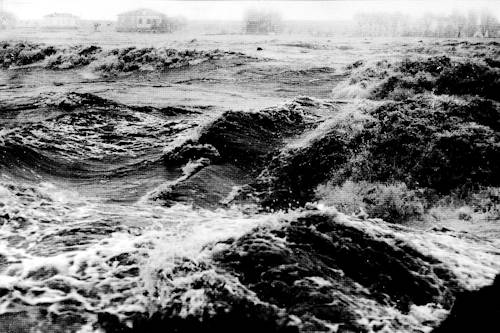 The first post-war solidarity campaign in which the firefighters actively engaged, concerns the overflow of the Po, the 14 November 1951 (photo). 8 billions of cubic meters of water invade the countryside. 107 thousand hectares of land on 150 thousand arable hectares are flooded. The crops destroyed.
The first post-war solidarity campaign in which the firefighters actively engaged, concerns the overflow of the Po, the 14 November 1951 (photo). 8 billions of cubic meters of water invade the countryside. 107 thousand hectares of land on 150 thousand arable hectares are flooded. The crops destroyed.
The structure of the named Central Mobile Column is born in the 1963 near Rome Montelibretti Multifunctional Center, who has always done and carries out training, research and rescue activities. The complex has seen a growing renewal up until 2002, when the birth of the Operational Training School: inside there are 16 training points of which 8 with real simulation system.
The rescue service of the firefighters continues the 9 1963 October with the landslide of Mount Toc in the waters of the Vajont dam. A high wave 200 meters completely overwhelms the neighboring countries that are reduced to piles of rubble and mud. 2500 people die and thousands are displaced. Firefighters worked uninterruptedly for 72 days and the people saved were 70.
The 7 may 1976 the earth trembles in Friuli to the north of Udine: thousands of firefighters intervene with over 600 means.
Two dramatic events occur in the 1980. At the 10.25 of the 2 in August, a bomb placed in the hall of the central station of Bologna provokes a devastating explosion causing the death of 85 perone and the wounding of other 200. Firefighters have the task of bringing first aid.
 The November 23 in Irpinia (photo), a strong earthquake invests an air of 17 thousand square kilometers. The figures of the tragedy are very heavy and firefighters intervene in the area with 4000 units and over 1000 vehicles. Once again, the fire brigade coming from every region of Italy, are working to save the survivors of the disaster and face the emergency.
The November 23 in Irpinia (photo), a strong earthquake invests an air of 17 thousand square kilometers. The figures of the tragedy are very heavy and firefighters intervene in the area with 4000 units and over 1000 vehicles. Once again, the fire brigade coming from every region of Italy, are working to save the survivors of the disaster and face the emergency.
Every year during the summer the National Fire Brigade is heavily committed to fight the scourge of forest fires that affects inhabited areas and tourist resorts throughout Italy.
The 28 August 1989 North Sardinia is scourged by a vast Mediterranean maquis, fueled by a strong mistral wind. 18 the dead caused by the fury of fire.
On board the tanker AVEN, in the 1991, a fire breaks out that causes an ecological disaster: in the relief operations an important naval and air component of the National Corps from all over the country is engaged.
The intervention of firefighters will be decisive, also, during the burning of the Theater The Phoenix of Venice and the Turin Cathedral. The immediate intervention of the operational teams made it possible to rescue the Holy Shroud. The defense of the immense artistic and cultural heritage of the country is another important task entrusted to the firefighters.
The emergency and rescue activities continue in 1997, when the earth trembles between Umbria and the Marches. In Assisi the collapse of the vault of the Basilica of San Francesco causes 4 dead. Firefighters will be involved in securing neighboring countries affected by the earthquake.
The destructive force of the water in the 2000, following violent storms, with the swelling of some torrents floods and destroys some Southern Italian countries, including Soverato in Calabria. Piedmont is also one of the most affected regions due to the flooding of some rivers that isolate many inhabited centers.
On the morning of November 27, 2001, team 6a, in via Ventotene in Rome, tries to intercept a gas leak from a conduit in a building. During the rescue operations a sudden and violent explosion involves 6 fighters. 4 of which will die. The certificates of condolence, esteem, gratitude and admiration towards the National Fire Brigade come in large numbers from all over Italy, to demonstrate how closely the country is linked to “its” Fire Brigade.
The collapse of the school of San Giuliano, following the earthquake that devastated some municipalities between Puglia and Molise, is remembered by many firefighters as one of the saddest events in the history of the country.
The 25 June 2006 the National Fire Brigade shows the DC-9 Itavia fallen on Ustica, in Bologna, from where he had left the evening of 27 years ago. The plane exploded mysteriously in flight due to uncertain cause. It was placed inside the Museum of Memory.
 The 2009 is also a busy year for the men and women of the National Corps. The 6 in April at 3.32 the earth trembles in Abruzzo with a shock of magnitude 5.8 of the Richter scale. The earthquake devastates the city of L'Aquila and its province provoking more than 300 dead. The incessant work of the fire brigade coming from all over the peninsula has saved many lives. In the days following the event, they dealt with the assistance to the population and the recovery of the assets from the uninhabitable houses as well as the historical-cultural assets. The silent work of the firefighters continues today, when about a year ago, the 24 last August a violent earthquake hit many areas of Lazio, Umbria, Abruzzo and Marche.
The 2009 is also a busy year for the men and women of the National Corps. The 6 in April at 3.32 the earth trembles in Abruzzo with a shock of magnitude 5.8 of the Richter scale. The earthquake devastates the city of L'Aquila and its province provoking more than 300 dead. The incessant work of the fire brigade coming from all over the peninsula has saved many lives. In the days following the event, they dealt with the assistance to the population and the recovery of the assets from the uninhabitable houses as well as the historical-cultural assets. The silent work of the firefighters continues today, when about a year ago, the 24 last August a violent earthquake hit many areas of Lazio, Umbria, Abruzzo and Marche.
In June of 2009 at 23.48 an entire district of Viareggio is destroyed by an explosion generated by the triggering of a cloud of LPG leaking from the tank wagons of a train.
A chronicle that from the post-war period to the L'Aquila earthquake, the railway accident in the countryside between Corato and Andria, the Messina flood, the recent earthquake in Central Italy, the international missions in Haiti and Chile and the numerous daily interventions in service of the citizens, confirm the Fire Brigade as a reference model for security for the whole country.
The National Corps of Firefighters won the prestigious award Conrad Dietrich Magirus Award: every year assigns the title of best "International Firemen's Team". And in this case, Italy won it for the relief interventions during the seismic events that hit Central Italy from the 24 last August. Magirus is the global brand that manufactures firefighting equipment supplied to firefighters, and the award wants to remember the commitment of the company founder who in addition to being an industrialist was a fireman. This is why it has been able to renew the instruments and improve the technology at the service of the firefighters. With this award Magirus has underlined the commitment and responsibility, as well as the proximity to the men and women called to face the emergencies of the community.
And scrolling through the list of gold medals for civil valor it is nice to imagine that each of those medals would have liked to pin it - as President Napolitano said - to the National Institute of the National Body, all the Italians who saw our work at work Fire fighters.
"Saving lives should have the same importance all over the world ": few concrete words that the national instructor of the Lecce Firefighters' Club Nucleus, Oronzo Passabì, pronounced on the stage during the award ceremony of the Magirus Award.
Start the journey of Defense Online in the heart of the emergency: we will live a firefighter day. We will get on board one of the Vigli del Fuoco helicopters during a joint training activity, between the Bari Firefighters' Helicopter Nucleus and the Lecce Fire Brigade Nucleo.
Also read: "Fire Brigade: selection, means, organization and training"
Also read: "Core Cowboys Firefighters: training in a rubble field"
